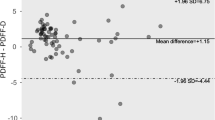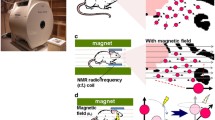Abstract
Object
The objective of this study was to determine the effects of a standardized fat rich meal and subsequent exercise on liver fat content by 1H MRS and on liver adenosine triphosphate (ATP) content by 31P MRS in healthy subjects.
Materials and methods
Hepatic 1H and proton decoupled 31P MRS were performed on nine healthy subjects on a clinical 3.0 T MR imager three times during a day: after (1) an overnight fast, (2) a following standardized fat rich meal and (3) a subsequent exercise session. Blood parameters were followed during the day to serve as a reference to MRS.
Results
Liver fat content increased gradually over the day (p = 0.0001) with an overall increase of 30 %. Also γ-NTP changed significantly over the day (p = 0.005). γ-NTP/tP decreased by 9 % (p = 0.019, post hoc) from the postprandial to the post-exercise state.
Conclusion
Our study shows that in vivo MRS can depict short lived physiological changes; entering of fat into liver cells and consumption of ATP during exercise can be measured non-invasively in healthy subjects. The physiological state may have an impact on fat and energy metabolite levels. Hepatic 1H and 31P MRS studies should be performed under standardized conditions.




Similar content being viewed by others
Abbreviations
- ANOVA:
-
Analysis of variance
- ASH:
-
Alcoholic steatohepatitis
- ATP:
-
Adenosine triphosphate
- FFA:
-
Free fatty acids
- FID:
-
Free induction decay
- GPC:
-
Glycerophosphocholine
- GPE:
-
Glycerophosphoethanolamine
- GTP:
-
Guanosine triphosphate
- HCT:
-
Hematocrit
- HDL-C:
-
High-density lipoprotein cholesterol
- IHCL:
-
Intra hepatocellular lipids
- ISIS:
-
Image selective in vivo spectroscopy
- LDL-C:
-
Low-density lipoprotein cholesterol
- MCH:
-
Mean corpuscular hemoglobin
- MCHC:
-
Mean corpuscular hemoglobin concentration
- MRS:
-
Magnetic resonance spectroscopy
- NADPH:
-
Nicotinamide adenine dinucleotide phosphate
- NTP:
-
Nucleoside triphosphate
- PC:
-
Phosphocholine
- PDE:
-
Phosphodiesters
- PE:
-
Phosphoethanolamine
- PEP:
-
Phosphoenolpyruvate
- Pi:
-
Inorganic phosphates
- PME:
-
Phosphomonoesters
- PtdC:
-
Phosphatidylcholine
- RDW:
-
Red blood cell distribution width
- SNR:
-
Signal-to-noise ratio
- T2DM:
-
Type 2 diabetes mellitus
- TG:
-
Triglycerides
- tP:
-
Total phosphorus
- WBC:
-
White blood cells
References
Lundbom J, Hakkarainen A, Söderlund S, Westerbacka J, Lundbom N, Taskinen M (2011) Long-TE 1H MRS suggests that liver fat is more saturated than subcutaneous and visceral fat. NMR Biomed 24:238–245
Khan SA, Cox IJ, Hamilton G, Thomas HC, Taylor-Robinson SD (2005) In vivo and in vitro nuclear magnetic resonance spectroscopy as a tool for investigating hepatobiliary disease: a review of 1H and 31P MRS applications. Liver Int 25:273–281
Gallis J, Delmas-Beauvieux M, Biran M, Rousse N, Durand T, Canioni P (1991) Is cellular integrity responsible for the partial NMR invisibility of ATP in isolated ischemic rat liver? NMR Biomed 4:279–285
Cortez-Pinto H, Chatham J, Chacko VP, Arnold C, Rashid A, Diehl A (1999) Alterations in liver atp homeostasis in human nonalcoholic steatohepatitis: a pilot study. JAMA 282:1659–1664
Nair S, Chacko VP, Arnold C, Diehl AM (2003) Hepatic ATP reserve and efficiency of replenishing: comparison between obese and nonobese normal individuals. Am J Gastroenterol 98:466–470
Szendroedi J, Chmelik M, Schmid AI, Nowotny P, Brehm A, Krssak M, Moser E, Roden M (2009) Abnormal hepatic energy homeostasis in type 2 diabetes. Hepatology 50:1079–1086
Dezortova M, Taimr P, Skoch A, Spicak J, Hajek M (2005) Etiology and functional status of liver cirrhosis by 31P MR spectroscopy. World J Gastroenterol 11:6926–6931
Rajanayagam V, Lee RR, Ackerman Z, Bradley WG, Ross BD (1992) Quantitative P-31 MR spectroscopy of the liver in alcoholic cirrhosis. J Magn Reson Imaging 2:183–190
Leij-Halfwerk S, Dagnelie PC, Kappert P, Oudkerk M, Sijens PE (2000) Decreased energy and phosphorylation status in the liver of lung cancer patients with weight loss. J Hepatol 32:887–892
Abdelmalek MF, Lazo M, Horska A, Bonekamp S, Lipkin EW, Balasubramanyam A, Bantle JP, Johnson RJ, Diehl AM, Clark JM, and the Fatty Liver Subgroup of the Look AHEAD Research Group (2012) Higher dietary fructose is associated with impaired hepatic adenosine triphosphate homeostasis in obese individuals with type 2 diabetes. Hepatology 56:952–960
Jalan R, Sargentoni J, Coutts GA, Bell JD, Rolles K, Burroughs AK, Taylor Robinson SD (1996) Hepatic phosphorus-31 magnetic resonance spectroscopy in primary biliary cirrhosis and its relation to prognostic models. Gut 39:141–146
Kiyono K, Shibata A, Sone S, Watanabe T, Oguchi M, Shikama N, Ichijo T, Kiyosawa K, Sodeyama T (1998) Relationship of 31P MR spectroscopy to the histopathological grading of chronic hepatitis and response to therapy. Acta Radiol 39:309–314
van Werven JR, Hoogduin JM, Nederveen AJ, van Vliet AA, Wajs E, Vandenberk P, Stroes ESG, Stoker J (2009) Reproducibility of 3.0 Tesla magnetic resonance spectroscopy for measuring hepatic fat content. J Magn Reson Imaging 30:444–448
Szczepaniak LS, Nurenberg P, Leonard D, Browning JD, Reingold JS, Grundy S, Hobbs HH, Dobbins RL (2005) Magnetic resonance spectroscopy to measure hepatic triglyceride content: prevalence of hepatic steatosis in the general population. Am J Physiol Endocrinol Metab 288:E462–E468
Yki-Järvinen H (2010) Nutritional modulation of nonalcoholic fatty liver disease and insulin resistance: human data. Curr Opin Clin Nut Metab Care 13(6):709–714
Magkos F (2010) Exercise and fat accumulation in the human liver. Curr Opin Lipidol 21(6):507–517
Boesch C, Egger A, Kreis R, Ith M, Krull I, Nuoffer J, Diem P, Stettler C, Christ ER (2008) ESMRMB 2008 Congress, Valencia, Spain, 2–4 October: abstracts, Saturday. 271. Intrahepatocellular lipids (IHCL) increase during exercise together with serum free fatty acids (FFA) while intramyocellular lipids (IMCL) decrease. Magn Reson Mater Phy Biol Med 21:176
Egger A, Kreis R, Allemann S, Stettler C, Diem P, Buehler T, Boesch C, Christ ER (2013) The effect of aerobic exercise on intrahepatocellular and intramyocellular lipids in healthy subjects. PLoS ONE 8:e70865
Shuhei N, Soderlund S, Jauhiainen M, Taskinen MR (2010) Effect of HDL composition and particle size on the resistance of HDL to the oxidation. Lipids Health Dis 9:104-511X-9-104
Adiels M, Matikainen N, Westerbacka J, Söderlund S, Larsson T, Olofsson S, Borén J, Taskinen M (2012) Postprandial accumulation of chylomicrons and chylomicron remnants is determined by the clearance capacity. Atherosclerosis 222:222–228
Fox SM 3rd, Naughton JP, Haskell WL (1971) Physical activity and the prevention of coronary heart disease. Ann Clin Res 3:404–432
Stefan D, Di Cesare F, Andrasescu A, Popa E, Lazariev A, Vescovo E, Strbak O, Williams S, Starcuk Z, Cabanas M, van Ormondt D, Graveron D (2009) Quantitation of magnetic resonance spectroscopy signals: the jMRUI software package. Meas Sci Technol 20:104035
Vanhamme L, van den Boogaart A, Van Huffel S (1997) Improved method for accurate and efficient quantification of MRS data with use of prior knowledge. J Magn Reson 129:35–43
Provencher SW (2001) Automatic quantitation of localized in vivo 1H spectra with LCModel. NMR Biomed 14:260–264
Hamilton G, Patel N, Forton DM, Hajnal JV, Taylor-Robinson SD (2003) Prior knowledge for time domain quantification of in vivo brain or liver 31P MR spectra. NMR Biomed 16:168–176
Murphy EJ, Rajagopalan B, Brindle KM, Radda GK (1989) Phospholipid bilayer contribution to 31P NMR spectra in vivo. Magn Reson Med 12:282–289
Schmid AI, Chmelík M, Szendroedi J, Krscaronscaronák M, Brehm A, Moser E, Roden M (2008) Quantitative ATP synthesis in human liver measured by localized 31P spectroscopy using the magnetization transfer experiment. NMR Biomed 21:437–443
Chemelík M, Valkovic L, Wolf P, Bogner W, Gajdosík M, Gruber S, Trauner M, Krebs M, Trattnig S, Krssák M (2013) Human bile phosphatidylcholine contributes to 31P MRS hepatic signal at 2.06 ppm. In: Proceedings of the 21st scientific meeting, international society for magnetic resonance in medicine, Salt Lake City, p 4090
Chmelik M, Povazan M, Krssák M, Gruber S, Tkacov M, Trattnig S, Bogner W (2014) In vivo 31P magnetic resonance spectroscopy of the human liver at 7T: an initial experience. NMR Biomed 27:478–485
Wylezinska M, Cobbold JFL, Fitzpatrick J, McPhail MJW, Crossey MME, Thomas HC, Hajnal JV, Vennart W, Cox IJ, Taylor-Robinson SD (2011) A comparison of single-voxel clinical in vivo hepatic 31P MR spectra acquired at 1.5 and 3.0 Tesla in health and diseased states. NMR Biomed 24:231–237
Laufs A, Livingstone R, Nowotny B, Nowotny P, Wickrath F, Giani G, Bunke J, Roden M, Hwang J (2014) Quantitative liver 31P magnetic resonance spectroscopy at 3T on a clinical scanner. Magn Reson Med 71:1670–1675
Rognstad R (1979) Rate-limiting steps in metabolic pathways. J Biol Chem 254:1875–1878
Khan SA, Cox IJ, Thillainayagam AV, Bansi DS, Thomas HC, Taylor-Robinson SD (2005) Proton and phosphorus-31 nuclear magnetic resonance spectroscopy of human bile in hepatopancreaticobiliary cancer. Eur J Gastroenterol Hepatol 17:733–738
Schulz G (1893) Experimentelle Untersuchungen über das Vorkommen und die diagnostische Bedeutung der Leukocytose. Dtsch Arch Klin Med 51:234–281
Alssema M, Schindhelm RK, Dekker JM, Diamant M, Nijpels G, Teerlink T, Scheffer PG, Kostense PJ, Heine RJ (2008) Determinants of postprandial triglyceride and glucose responses after two consecutive fat-rich or carbohydrate-rich meals in normoglycemic women and in women with type 2 diabetes mellitus: the Hoorn Prandial Study. Metab Clin Exp 57:1262–1269
Parks EJ, Hellerstein MK (2006) Thematic review series: patient-oriented research. Recent advances in liver triacylglycerol and fatty acid metabolism using stable isotope labeling techniques. J Lipid Res 47:1651–1660
van Oostrom AJ, van Dijk H, Verseyden C, Sniderman AD, Cianflone K, Rabelink TJ, Castro Cabezas M (2004) Addition of glucose to an oral fat load reduces postprandial free fatty acids and prevents the postprandial increase in complement component 3. Am J Clin Nutr 79:510–515
Acknowledgments
We are grateful to Helinä Perttunen-Nio for excellent laboratory work and to volunteers for participation. This study was funded by the Waldemar von Frenckells Foundation, the Finnish Diabetes Association, the Orion-Pharmos Foundation, Mary and Georg C. Ehrnrooths foundation and Helsinki University Central Hospital: a special governmental subsidy for health sciences research (TLD8100061 and TLD8100073).
Author information
Authors and Affiliations
Corresponding author
Rights and permissions
About this article
Cite this article
Hakkarainen, A., Lundbom, J., Tuominen, E.K. et al. Measuring short-term liver metabolism non-invasively: postprandial and post-exercise 1H and 31P MR spectroscopy. Magn Reson Mater Phy 28, 57–66 (2015). https://doi.org/10.1007/s10334-014-0450-7
Received:
Revised:
Accepted:
Published:
Issue Date:
DOI: https://doi.org/10.1007/s10334-014-0450-7




